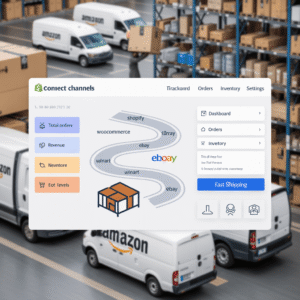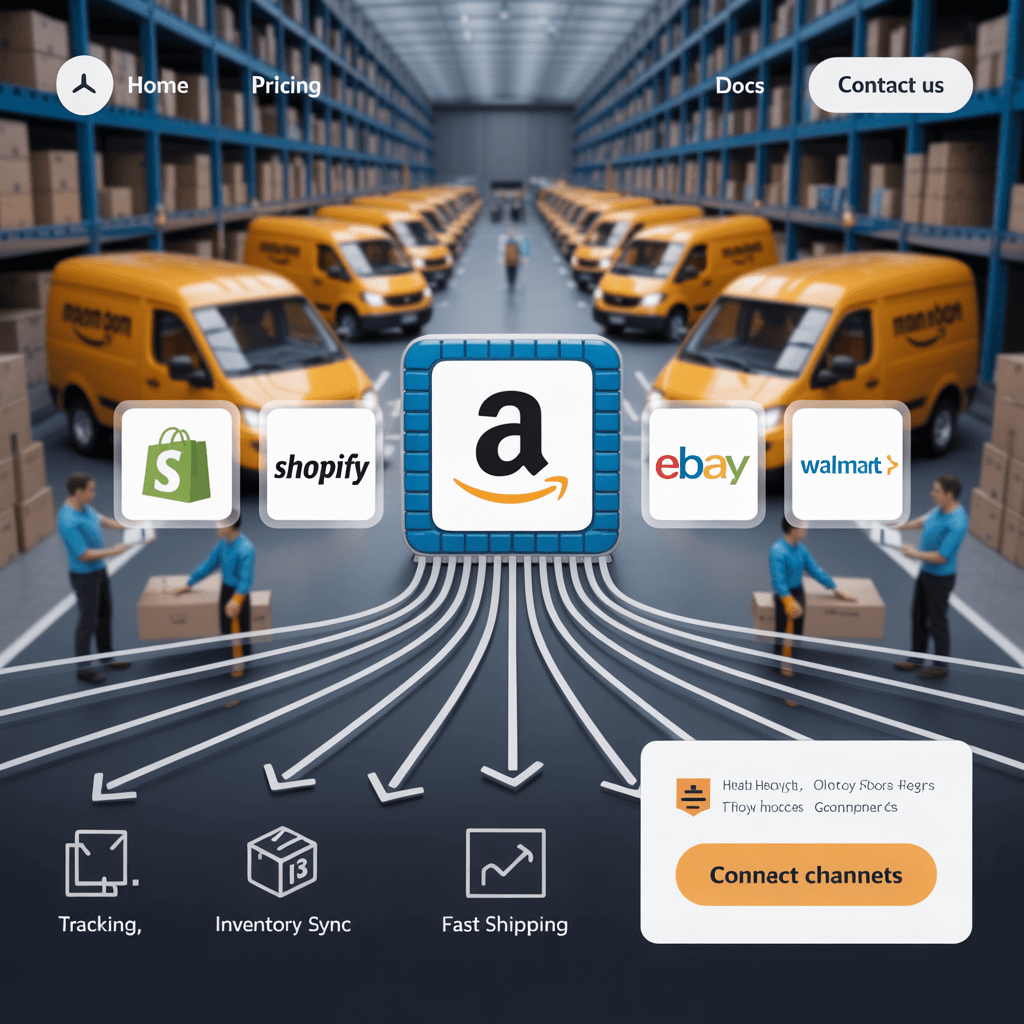Managing Amazon is one thing. But juggling orders from your Shopify store, eBay listings, or WooCommerce site? That’s a nightmare. Inventory gets out of sync, shipping gets delayed, and customers get cranky. You’ve got multiple channels, but not enough time (or hands) to keep them all running smoothly.
Amazon Multi-Channel Fulfillment (MCF) is a 3PL service that lets e-commerce sellers use Amazon’s logistics network to handle orders from other platforms. That includes your own website, marketplaces like eBay, or even social media shops. Amazon picks, packs, and ships the products, even when the sale doesn’t happen on Amazon.
And if you’re not into managing all that manually, Manage Amazon can automate the entire workflow so you stay focused on growth, not operations.
What is Amazon MCF?
Amazon MCF (short for Multi Channel Fulfillment by Amazon) lets you fulfill orders from any sales channel using Amazon’s warehouse and shipping network. You don’t need to sell the product on Amazon for Amazon to ship it.
You can sell on Shopify, Etsy, WooCommerce, Walmart, eBay, or even your own custom website and Amazon will handle the picking, packing, shipping, and even customer service.
In short, MCF = FBA but for all your other channels too.
Why Ecommerce Sellers Are Turning to Multi Channel Fulfillment by Amazon
Here’s the real appeal: running multiple sales channels is hard. You’re tracking inventory across platforms, using different shipping methods, trying to match customer expectations, and dealing with returned packages. It drains your time and resources.
MCF turns that chaos into order:
- One centralized inventory
- Faster shipping with Prime-level logistics
- Tracking and notifications handled
- Reduced human error
- Easier returns
And most importantly, more time to focus on sales instead of shipping. For those working in competitive eCommerce niches, MCF can be the operational edge that keeps you lean, agile, and profitable.
Streamlining the Entire Fulfillment Process
Let’s walk through what actually happens when you use Amazon Multi Channel Fulfillment:
1. Order Transmission
When a customer places an order on a non-Amazon store (like Shopify, WooCommerce, or BigCommerce), you have two choices: automate the process using multi channel fulfillment software or manually upload the order into Amazon MCF.
Most serious sellers use integrations that automatically push orders to Amazon in real time. This step eliminates manual processing and reduces order entry errors. You stay in control of the customer experience without physically touching a thing.
2. Inventory Check and Fulfillment
Once the order hits Amazon’s system, MCF checks your available FBA inventory. It instantly confirms if stock is ready to go. This sync ensures you don’t oversell or delay shipments.
If stock is unavailable, you get notified so you can take action immediately. Amazon’s real-time fulfillment logic means the process begins almost instantly after confirmation, shaving hours off your fulfillment timeline.
3. Packaging and Shipping
After inventory confirmation, Amazon begins the picking and packing phase. MCF orders are processed with the same precision and speed as Prime orders. You can select between three shipping speeds—Standard (3–5 business days), Expedited (2-day), and Priority (next-day)—based on what your customer paid for.
If you don’t want Amazon-branded packaging, you can select unbranded packaging (available in some regions). This makes it feel like the product shipped directly from your own warehouse.
4. Tracking and Notifications
Amazon generates tracking details as soon as the order ships. If you’re using a multichannel fulfillment tool or ecommerce platform integration, this tracking is automatically sent to your store and then emailed to your customer.
You don’t need to manually send shipping updates, which saves time and avoids mistakes. MCF also keeps a log of every order, so you can view delivery status, troubleshoot, and manage issues without third-party involvement.
5. Returns & Customer Support
Amazon Multi Channel Fulfillment supports full returns, including prepaid return labels and refund processing. When a customer initiates a return, you can either direct them to use your standard return policy or leverage Amazon’s return service.
Either way, Amazon handles the physical logistics of receiving and restocking the product. You stay updated through notifications but don’t need to intervene unless there’s a customer-specific issue. This makes MCF one of the most hands-off return systems available for multi-channel ecommerce sellers.
Amazon MCF vs FBA: What’s the Difference?
At first glance, they seem similar, but here’s how they compare:
| Feature | FBA (Fulfillment by Amazon) | MCF (Multi Channel Fulfillment) |
| Sales channel | Only Amazon | All ecommerce platforms |
| Branding on packages | Amazon-branded | Generic packaging (optional) |
| Customer gets Amazon perks | Yes (Prime, etc.) | No |
| Shipping cost structure | Included in Amazon fees | Separate MCF fees |
| Customizable delivery speed | Limited | More options |
So if you’re wondering, what is MCF Amazon good for? The answer is: everything outside Amazon itself.
Is Amazon MCF Economically Efficient?

Yes, in most cases, Amazon MCF pricing is competitive compared to third-party logistics (3PL) providers. You save money on warehousing, packing supplies, and labor.
Let’s look at MCF fees:
- Starts at $3.99 per unit for standard-size domestic orders
- Expedited and priority shipping available
- No requirement for branded packaging
Plus, the new Amazon MCF fees calculator helps estimate your costs before you commit.
It removes the need for managing separate fulfillment works teams or worrying about warehouse leases. For lean businesses, this is a major win. If you’re looking to increase product sales without increasing fulfillment headaches, MCF is worth exploring.
Amazon MCF with Shopify, eBay, and More
Amazon MCF integrates with many platforms:
- Shopify Fulfillment by Amazon MCF
- WooCommerce via plugins
- Walmart and eBay via tools like ShipStation or Multiorders
- Custom stores via Amazon MCF API
Even if you use ShipBob or other 3PLs, you can test Amazon MCF alongside them to compare performance.
For sellers using omni-channel logistics, this approach creates unified fulfillment without hiring more people.
Best Practices to Maximize Your Multi Channel Fulfillment Setup
- Keep your inventory synced between Amazon and all channels. Overselling leads to bad reviews.
- Use automation tools like Orderhive or Multiorders to streamline order routing.
- Use plain packaging if you don’t want Amazon logos on your non-Amazon shipments.
- Monitor delivery performance using MCF reports.
- Use the MCF calculator before listing to check profit margins.
These tips make multi channel order fulfillment software work even better for your store.
Manage Amazon: Automation That Actually Works
Many sellers still hesitate because they think Amazon automation is a scam. Here’s the truth: it’s only a scam when amateurs do it.
Manage Amazon is a real team running real stores with real fulfillment pipelines. We handle everything:
- Listing and product optimization
- FBA and MCF order routing
- Customer messaging and support
- Returns and shipping
- Reporting and inventory
You already trust Amazon with your fulfillment. Now trust us with your operations.
Quick Answers to Common Questions
What does MCF stand for?
MCF stands for Multi Channel Fulfillment. It’s Amazon’s way of letting sellers like you use their massive fulfillment network for orders placed outside Amazon. Whether it’s your Shopify store, Etsy, or WooCommerce site, MCF handles the backend work so you don’t have to.
What is MCF?
MCF is a fulfillment service from Amazon that allows you to process and ship orders received on non-Amazon sales channels. It works just like FBA, but for your external platforms. You list the products, Amazon ships them out, and your customers get reliable service without extra effort from you.
How are MCF fees calculated?
Amazon MCF fees are calculated based on three core things: product size, weight, and the shipping speed selected. Standard, Expedited, and Priority have different price points. You can use the Amazon MCF calculator to estimate costs in advance and decide what works best for your business.
Is MCF available in Canada?
Yes, Amazon MCF is fully operational in Canada. Canadian ecommerce sellers can now access Amazon’s robust logistics network to fulfill orders across channels. It’s a great option for reaching more customers without setting up a local warehouse.
What is multi format on Amazon?
Multi format refers to the variety of packaging, listing styles, and content formats sellers can use depending on the target customer or platform. In the context of MCF, it can also relate to packaging customization like Amazon-branded versus plain boxes.
Is Amazon MCF better than 3PL?
In many cases, yes. Amazon MCF offers faster delivery, proven reliability, and better infrastructure compared to most traditional 3PL providers. It’s especially useful for sellers already using FBA, as it keeps inventory management centralized and simple.
The Bottom Line
If you’re selling on more than one platform and still shipping manually or using outdated 3PLs, Amazon Multi Channel Fulfillment can change everything.
It gives you Prime-like shipping without being tied to Amazon alone. It’s flexible, efficient, and backed by a global infrastructure.
And with Manage Amazon, you don’t even need to learn the logistics side. We’ll take care of that while you grow your brand.



